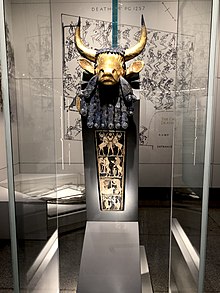Bull Headed Lyre of Ur
| Bull Headed Lyre of Ur | |
|---|---|
 Bull Headed Lyre of Ur as displayed in the Penn Museum | |
| Material | Gold, silver, copper, bitumen, shell, & lapis lazuli |
| Size | Head dimensions: 40 cm long, 25 cm wide, 19 cm deep |
| Created | 2550–2450 BCE |
| Present location | Penn Museum, Philadelphia |
| Identification | Penn Museum Object Number B17694B |
The Bull Headed Lyre is one of the oldest string instruments ever discovered. The lyre was excavated in the Royal Cemetery at Ur during the 1926–1927 season of an archeological dig carried out in what is now Iraq jointly by the University of Pennsylvania and the British Museum. Leonard Woolley led the excavations.
The lyre was found in “The King’s Grave”, near the bodies of more than sixty soldiers and attendants.
Composition
The Mesopotamian sun god Utu/Shamash was often taken to assume the form of a bull, particularly in his role at sunrise, and is the figure most frequently described in some cuneiform texts as having a lapis lazuli beard.[2] For these reasons, the Penn Museum has asserted that the bull head of the lyre is a representation of Utu/Shamash.[3] The head was made of a single piece of gold plating over a wooden core (now disintegrated) with gold plated ears and horns attached with small pegs.[4] The beard is made of carved lapis lazuli tesserae on a silver backing. The tips of the bull's horns are also lapis lazuli, making this the only animal-shaped lyre at Ur to have horns tipped in a separate material.[1] The eyes of the bull are shell and lapis lazuli strung with copper wire.[4] In its dimensions, the bull's head is 40 cm long, 25 cm wide, and 19 cm deep.[5]
The lyre has a front panel which depicts four scenes linked to Early Mesopotamian funerary rituals. The designs are made of shell inlay on bitumen.[4] The first panel shows a man wrestling two bulls with human heads. The second shows a hyena serving meat and a lion bearing a jar. The third shows an equine animal playing a bull shaped lyre, while a bear supports the lyre, and another animal holds a rattle. The lowest register shows a scorpion man who guards the underworld, greeting a man.[3] In addition to his role as sun god, Utu / Shamash was the judge of the dead.[6] In the lyre, he can be seen as presiding over the events represented in the panel affixed below his head.
The lyre's wooden sound box had disintegrated by the time of its excavation, however Woolley's measurements of the box's imprint, as well as casts made from another lyre in the cemetery, have provided the basis for attempts at recreation.[1]
Restoration
The plating of the bull's head had collapsed and torn once the wooden core had deteriorated. The bitumen of the front panel had been pulverized, dislodging the shell inlay. Both were originally restored at the British Museum. When they arrived at the Penn Museum a new sound box was created, and painted by watercolorist M. L. Baker.[3] Its excavator, L. Woolley, visited the museum in 1955, and remarked that the reproduction soundbox seemed too large. Measurements of the lyre's imprint taken during the excavation later verified this observation.[3]

The museum created a new sound box drawing from these measurements in 1976.[3] The restoration was intended only to recreate the outward appearance of the original lyre; the restoration was not intended to recreate a playable instrument, nor to approximate the sound quality of the original.[1] A different, functioning replica of it is being played as part of a touring ensemble.[7][8]
That same year, plans to clean and enhance the appearance of the head and plaque led to the discovery of extensive deterioration.[1] In 1977, work began to restore the bull head and the plaque.[3] The head was dismantled and reassembled to expose more of the original work, straighten the ears, and preserve the integrity of the construction.[1]
Additional fragments from the field which had been mistakenly omitted from the lyre's parts-list were re-incorporated into the design, and plaster from the first restoration was removed.[4] Following some experimentation a type of polyethylene glycol wax found to fill the head, which preserves its strength and is removable.[4] These processes, along with X-Rays, have uncovered new information about the head's construction.[1]
After the sound box's second reconstruction, the lyre's size increased by about a third, suggesting that the lyre must have been steadied by a second person in order for it to be played.[1] This matches the second image of the adjoining plaque which shows two creatures playing in this manner.[1]
See also
References
- ^ a b c d e f g h i j
de Schauensee, Maude (2002). Two lyres from Ur. University of Pennsylvania Museum of Archaeology and Anthropology. p. 63.OCLC 929651863. - ^
Polonsky, Janice (2002). The Rise of the Sun God and the Determination of Destiny in Ancient Mesopotamia. pp. 204, 193, 197. OCLC 635163016.
- ^ a b c d e f
"Lyre". Penn Museum. Retrieved 2019-04-09. - ^ a b c d e
Greene, Virginia (2003). "Conservation of a Lyre from Ur: A treatment review". Journal of the American Institute for Conservation. 272–273 (2): 265–270.JSTOR 3180072. - ^ "Lyre fragment: Bull head". Penn Museum. Retrieved 25 April 2019.
- ^
Smith, Brian (2007). Your Rays Cover the Earth Like a Net: Literary and iconographic portrayals of the sun-god in ancient Mesopotamia. p. 70. OCLC 320741229.
- ^ "Ancient Iraqi harp reproduced by Liverpool engineers" (Press release). University of Liverpool. 28 July 2005. Archived from the original on 1 July 2010. Retrieved 2009-11-23.
A team of engineers at the University of Liverpool has helped reproduce an ancient Iraqi harp - the Lyre of Ur
- ^ Taylor, Bill. "Golden Lyre of Ur". Archived from the original on 2011-06-11.
